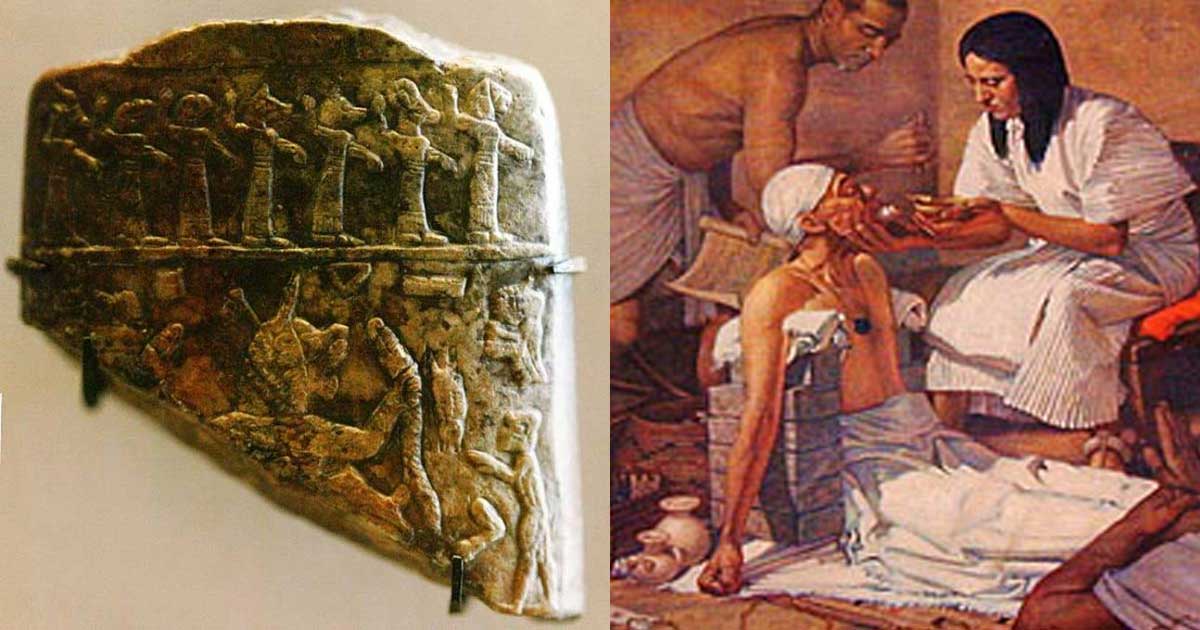Mixing Magic and Medicine: New Study Shows Mesopotamian Doctors Had to Battle Demons
Analysis of a collection of clay tablets confirms that a Mesopotamian doctor had to deal with more than just physical ailments. The ancient healer was expected to exorcise demons, ward off witchcraft, and appease the gods – all while staying up to date on the latest medical-magical healing strategies!
The recent study demonstrates that doctors living in Mesopotamia in the 7th century BC were expected to combine what we commonly call magical rituals with “harder science” and medicine if they wished their patients to recover.

Fragment of talisman used to exorcise the sick, Assyrian era. (Rama/ CC BY SA 2.0 )
Science Nordic reports the research came about through the work of Dr. Troels Pank Arbøll from the Department of Cross-Cultural and Regional Studies at the University of Copenhagen in Denmark. Although the clay tablets written by an Assyrian doctor named Kisir-Ashur have been known about for decades, Arbøll completed the first known analysis on the complete collection of writings.
As Phys.org mentions, the term “doctor” has been applied to Kisir-Ashur based on his level of education and the information he provides on his work. Kisir-Ashur documented his training and healing techniques – thus his work provides unique insight into the education and practice of medicine at the time. Arbøll says,
“The sources give a unique insight into how an Assyrian doctor was trained in the art of diagnosing and treating illnesses, and their causes. It’s an insight into some of the earliest examples of what we can describe as science.”
- Mesopotamian Ghostbusters: The Evil Acts of Assyrian Ghosts and How They Were Vanquished
- Medical Astrology: Moon Fever and Diseases Sent from the Skies
While in training, Kisir-Ashur began with treating animals and then babies. The doctor was not allowed to heal adults until his studies were complete. According to Arbøll, “This shows a relatively clear chronology in his training, where he takes on more and more responsibility.”
Assyrians believed that gods, demons, and ghosts were at the root of human illness, social and economic problems – doctors such as Kisir-Ashur were expected to heal all these issues. Disease was seen as the result of punishment for sins or inappropriate behavior, or witchcraft. This means that ancient Mesopotamian healers had to be ready with a variety of tools and rituals, even to perform exorcisms, in their treatments.

Assyrian Cylinder depicting an exorcism. (Wellcome Images/ CC BY 4.0 )
Ancient Origins has described some of the practices Mesopotamian doctors used to treat disease. Caleb Strom writes that a doctor would perform exorcisms to rid patients of their problems. The first step was to ask patients to be sincere about any wrongdoings they may have committed against ghosts or the gods. After that,
“Assyrian exorcisms involved magical rituals, incantations, and invocation of deities such as the god Shamash. Shamash was the Mesopotamian sun god as well as the god of justice. He was believed to visit the underworld every night after sunset to judge the dead. Because of being the god of justice and a god associated with the dead, those suffering from haunting or possession would often invoke him in prayers or magical rituals hoping that he could resolve the matter by pacifying or restraining the ghost.”

The king with a mace, who stands on a rectangular checked board dais, follows the suppliant goddess (with necklace counterweight), and the robed king with an animal offering. They stand before the ascending Sun god, Shamash, who holds a saw-toothed blade and rests his foot on a couchant human-headed bull. (CC BY SA 3.0)
But exorcisms were not the only tool for doctors such as Kisir-Ashur. Arbøll explains, “He does not work simply with religious rituals, but also with plant-based medical treatments […] Kisir-Ashur observed patients with bites or stings. Perhaps he did this to find out what the toxins had done to the body and from that, try to understand the venom’s function.”
- Oneiromancy and Dream Predictions from Ancient Mesopotamia
- Deciphering Cuneiform: Helping Scholars to Get a Handle on Life in Ancient Mesopotamia
Some of the beliefs Kisir-Ashur and his contemporaries held seem to have similarities with ancient Greek medicine. For example, they may have believed some diseases were linked to liquids. Arbøll’s study suggests that Assyrian doctors apparently viewed bile as a toxin. “This idea is reminiscent of the important Greek physician, [Hippocrates’] theory of humors, where the imbalance of four fluids in the body can be the cause of illness,” Arbøll says.

Hippocrates, engraving by Peter Paul Rubens, 1638. Courtesy of the National Library of Medicine. (Public Domain)
Nonetheless, there is some difference between the concepts and a large amount of time and space between the lives of Kisir-Ashur and Hippocrates, so this idea, however appealing it may seem, is only a tentative one.
Arbøll acknowledges this and also states that his study of Kisir-Ashur’s training and medical practice may not have followed all trends during his lifetime, “It's a snapshot of history that is difficult to generalise and it is possible that Kisir-Ashur worked with the material in a slightly different way than other practising healers,” yet “Kisir-Ashur copied and recorded mostly pre-existing treatments and you can see that he catalogues knowledge and collects it with a specific goal.”
Top Image: Fragment of talisman used to exorcise the sick, Assyrian era. (Rama/ CC BY SA 2.0 ) A doctor with a patient. (patrickhunt.net)



















